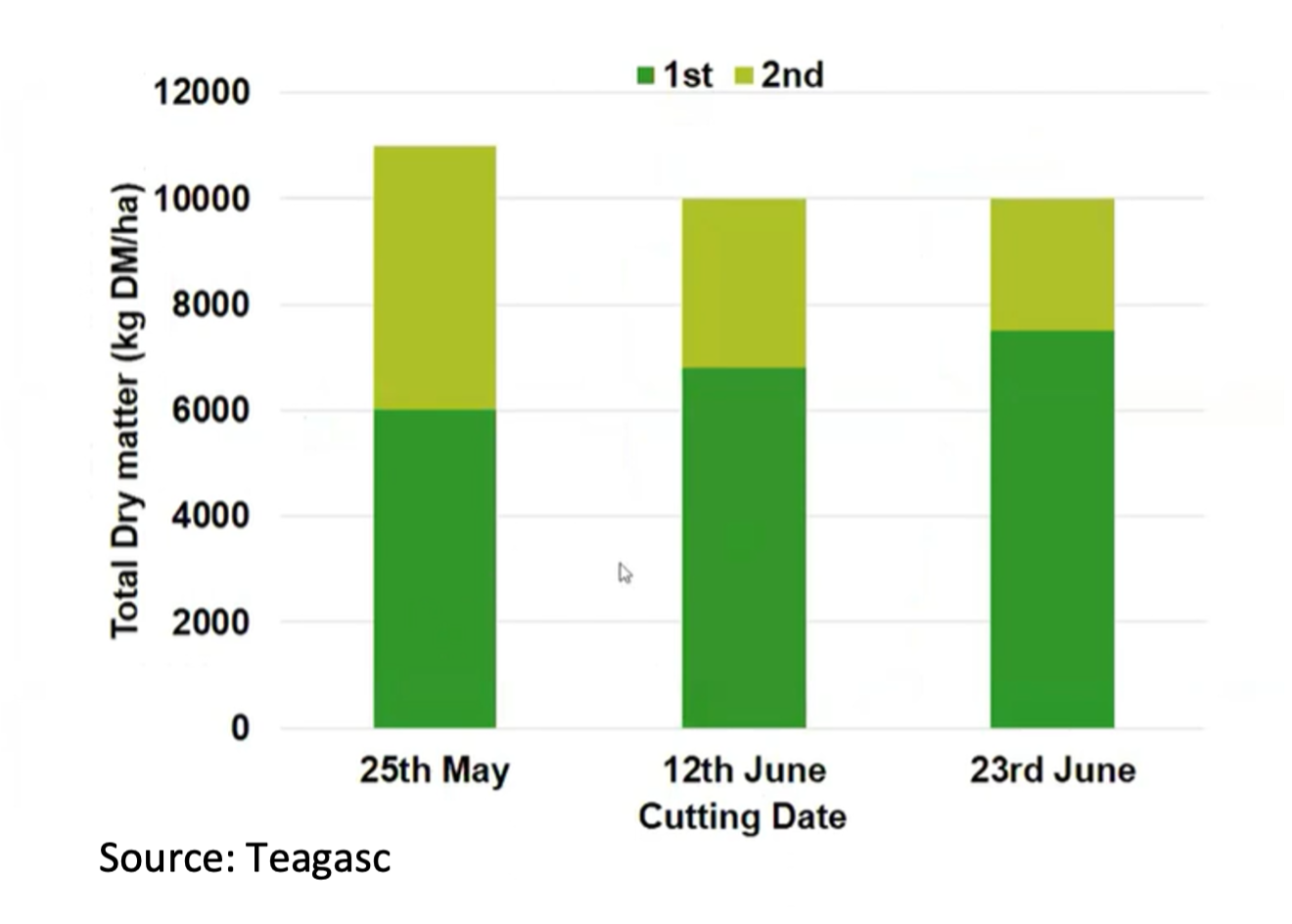Fertiliser advice for 1st cut silage
With the prolonged winter feeding, the back of silage pits were emerging on farms. It is essential that the focus must be on replenishing these silage pits with high quality 1st cut silage. Cutting date should not be postponed considering the poor conditions in February or March, this will only intensify any forage shortages next winter.
Cutting early will be paramount to achieving quality and quantity of subsequent cuts. Aim to for cutting date in mid-May or even earlier if possible. Cutting early ensures that subsequent cuts won’t be delayed, maximising annual yield (Figure 1.). Prioritising an early cut over a “bulky” 1st cut will ultimately not only maintain feed quality but also maximise yield from the 2nd cut crop by capturing May and early June growth rates. It also provides the possibility of a 3rd cut where forage deficits are flagged and where a 25% reserve needs to be built.

Source: Teagasc
Nitrogen:
Nitrogen is vital to drive growth to secure sufficient grass for 1st cut silage and to capitalise on the higher grass growth rates in April and early May. Where weather and ground conditions allow do not hesitate to apply.
Grass will take up on average 2.5kg/ha/day of N (2units/day), therefore for where nitrogen application is delayed in light of weather and ground traffic ability it should be reduced on a pro rata basis (i.e. 40 days X 2 units per day = 80 units). Recently reseeded swards (0-3 years) will have 25% higher N demand, particularly if they were reseeded after a tillage rotation.
Under wetter soil conditions, it is advisable to split fertiliser N application with 50% applied initially and the remaining 50% applied 7 to 10 days later to mitigate the risk of N loss.
Phosphorus (P) and Potassium (K)
A crop of grass silage will remove approximately 4kg P and 25kg K /tonne of grass DM. Normally nutrient applications for silage would be a combination of slurry and chemical N. Slurry would have supplied majority of the P and K requirements. However, a lot of farms haven’t be able to get slurry out on silage ground. Silage ground that hasn’t received slurry to date and is ungrazed, slurry application should be reserved for until after the 1st cut. Farmers in consultation with their local advisor should look to get their P & K requirements and allowance to select a suitable compound fertiliser to provide the optimal nutrients based on the targeted grass yield.
Keep in mind to limit K applications to 90 kg/ha in spring. This is to avoid luxury amounts of K taken up by the plant which can lead to milk fever if fed to dry cows. Likewise grazing ground, heavy K applications on can increase the risk of grass tetany. Where more than 90 k/ha is advised, only 90 K should be applied and the remainder after cuts or in late autumn.
|
1st Cut Grass Silage N, P & K Requirements (5t/ha DM) & Suggested Fertiliser Programmes |
|||||
|
Soil Index |
N kg/ha (units/ac) |
P kg/ha (units/ac) |
K kg/ha (units/ac) |
Suggested Fertiliser Options3,4 |
|
|
No Slurry1,4 (bags/ac) |
+ Cattle Slurry 4,5 3,000gal/ac |
||||
|
11 |
125 (100) |
40 (32) |
175 (140) |
3.5 bags/ac 13-6-20 1.4bags/ac ProUrea |
1.9 bags/ac ProUrea + S |
|
21 |
125 (100) |
30 (24) |
155 (120) |
3.5 bags/ac 13-6-20 1.4bags/ac ProUrea |
1.9 bags/ac ProUrea + S |
|
3 |
125 (100) |
20 (16) |
125 (100) |
3.0 bags/ac 13-6-20 1.6bags/ac ProUrea |
1.9 bags/ac ProUrea + S |
|
42 |
125 (100) |
0 |
0 |
2.5bags/ac ProUrea |
2.5 bags/ac ProUrea |
1Index 1, 2 & 3 soils apply P & K balance to build / maintain soil P & K levels to after grass for example apply as 18-6-12 / 0-7-30 / Cattle slurry / etc…
2Index 4 soils omit P for 2/3 years & retest, Index 4 K omit for 1 year and revert to index 3 advice thereafter until next soil test. Avoid applying cattle on Index 4 soils.
3For new / older swards with higher / lower yield potential reduce N, P, K by 25 kg N, 4kgP & 25kg K per tonne of grass dry matter (DM).
4 Protected Urea + S = Protected Urea (Urea 38% N + 7.5% S)
5Cattle slurry (6.3% DM) assumed to be applied by low emission techniques (LESS) – Slurry N-P-K = 9-5-32
Source: FAI
Sulphur:
Adequate sulphur levels in the soil are particularly important to optimise nitrogen utilisation by the sward. Sulphur deficiency can reduce plant vigor, decease photosynthesis activity and ultimately lower yields and inferior silage quality. Sulphur deficiency is mostly on light sandy /free draining soils with low organic matter but no confined to those. Grass silage crops have a requirement of 20kg S/ha per cut and should be applied with the main N split as N +S (e.g. CAN +S / Protected Urea +S)
First Published 19 April 2024
Tagged with: Dairy
